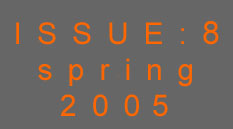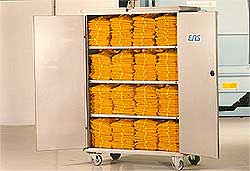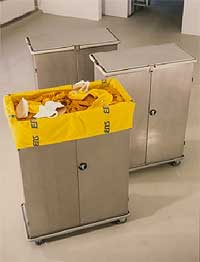 |
 |
Issue No.8 Spring
|
| ENS News |
| ENS Events |
| Member Societies & Corporate Members |
YGN Report |
| European Institutions |
| ENS World News |
ENS Members |
| Links to ENS Member
Societies Links to ENS Corporate Members Editorial staff ______________________ |
  |
| _____________________ |
|
|
|
|
Mr. Eckhard Raabe |
Mr. Roelof Hadders |
| Mr. Manfred Wilke |
This paper has been condensed from its original version to meet publication requirements. The full document is available upon request from the authors.
I. INTRODUCTION
Off-site decontamination of protective clothing
is new in Europe. In the past, facilities established their own
on-site laundries and decontaminated their own protective clothing.
But, operating a laundry within an operating nuclear facility
brings with it a number of complicated problems, including staffing,
variable workloads, wastewater, and as a support priority it is
often not handled as well as it could be.
For the past five years, the former Siemens fuel rod fabrication
facility in Hanau, Germany, has been using the services of an
off-site laundry service provider (LSP) for cleaning radioactively
contaminated protective clothing. This paper discusses the decision
making process
II. LOCATION OF THE LAUNDRY AND OBTAINING APPROVALS
The LSP is located in Coevorden, The Netherlands.
Centrally located, it is able to service many European nuclear
facilities while minimizing transport distances. Coevorden offers
a friendly regulatory environment and reliable, educated employees.
The LSP has a broad scope nuclear materials license, meaning it
can accept almost any radionuclide providing the quantities do
not exceed license limits. The framework for transport of radioactive
materials is defined in European ADR regulations, German GGVS
(Gefahrengutverordnung Strasse), and laws governing health physics
in each European country where the LSP provides services. Permits
are obtained in each country through which a shipment passes as
required.
Waste is generated as sludge from the wastewater processing system
and drying lint. Dutch regulators consider laundering as a value
added process taking place in the Netherlands. Therefore waste
is generated in the Netherlands in accordance with the Dutch Nuclear
Power Act and transported off site to the COVRA – the Netherlands’
radioactive waste disposal site.
Key factors for going off-site were cost and the fact that the
company shut down its fuel fabrication facility which involved
decommissioning the on-site laundry.
III. PROCESS FLOW DESCRIPTION
Customers are provided clean, folded, and sorted clothing in the LSP’s special transport container (see Fig. 1). The containers are on wheels and can be delivered directly to the point of use, eliminating extra handling.
|
Bags containing dirty laundry
are sealed and then placed into the open top of the lined
LSP’s containers. When a container is full, the liner
is sealed and the container is checked for radioactivity
in preparation for return to the LSP. |
special plastic scintillator detector to monitor incoming containers (see Fig.2). The monitor alarms if radiation levels are exceeded.

Fig. 2 Container entrance monitor
A crane lifts the sling bag out of the container
to a downdraft sorting table. The table rotates and workers stationed
around the perimeter sort items into like types. Integrated ventilation
systems avoid any need for worker respiratory protection.
The laundry is placed into 250 kg capacity washing machines. These
industrial washers generate considerably more agitation and “fall”
than smaller washers in use at nuclear facilities. Washing large
loads improves economy and is one reason why the LSP is able to
do laundry at less cost. After washing, laundry is dried in industrial
dryers sized to match washing capacity.
Clean clothing is placed on an Automatic Laundry Monitor (“ALM”).
The LSP has designed world-class belt-driven gas flow proportional
ALMs capable of detecting very low levels of alpha and beta-gamma
contamination (see Fig. 3). Each ALM has 88 individual detectors
arranged to fully monitor every square centimetre of an item.
This gives Siemens confidence that 100% of the clothing is being
directly measured for radioactivity in a repeatable and reliable
manner that outperforms human inspection method.
Finally, clean laundry is sorted and packed by item, size and
color and packed into the transport containers for return to the
customer.

Fig. 3: Alpha/beta gas flow monitor ALM
IV. NUMBER OF SHIPMENT AND AMOUNTS OF LAUNDRY AND RADIOACTIVE MATERIALS
The quantities processed in one calendar year are as follows:
-
24 Total Shipments
-
2,1 E8 Bq Total Activity
-
6 Bq/g Specific Activity
-
24,463 kg Laundered Clothing
-
27,211 Coveralls
-
15,277 Gloves
-
57,181 Overshoes
-
318 Containers Of Soiled Laundry

Fig.4: Transport container with clean coveralls
The LSP is periodically audited by Siemens and others. Audits confirm that the off-site laundry is operating according to its design specification, procedures, and governmental requirements.
V. COSTS
In addition to logistical considerations Siemens
wanted to provide laundry service at the lowest possible cost.
Siemens evaluated four different LSP offerings.
The LSP offers lease clothing and disposable clothing. A key
factor was that Siemens already owned sufficient protective
clothing inventory. Figure 5 depicts the savings attributed
to having the LSP launder the existing clothing inventory.

Fig. 5: Cost comparison
VI. SYNOPSIS
The Siemens project demonstrates that off-site
laundry service offers a number of advantages to managing an
on-site laundry. The LSP is better equipped to do the job with
high-volume throughput using efficient, high-performance equipment.
Outsourcing eliminates the need to hire permanent and peak-need
temporary laundry workers. Off-site service eliminates management
of laundry wastewater and other health physics tasks –
daily radiation checks, air sampling, etc., that are part of
operating a laundry.
The LSP worked together with Siemens to ensure service was satisfactory
and the LSP was willing to help whenever problems arose. There
have been no problems with transporting radioactive material
during the course of the project. In summary, the process has
saved Siemens money while providing laundry service better than
Siemens could have done on its own.
| |



